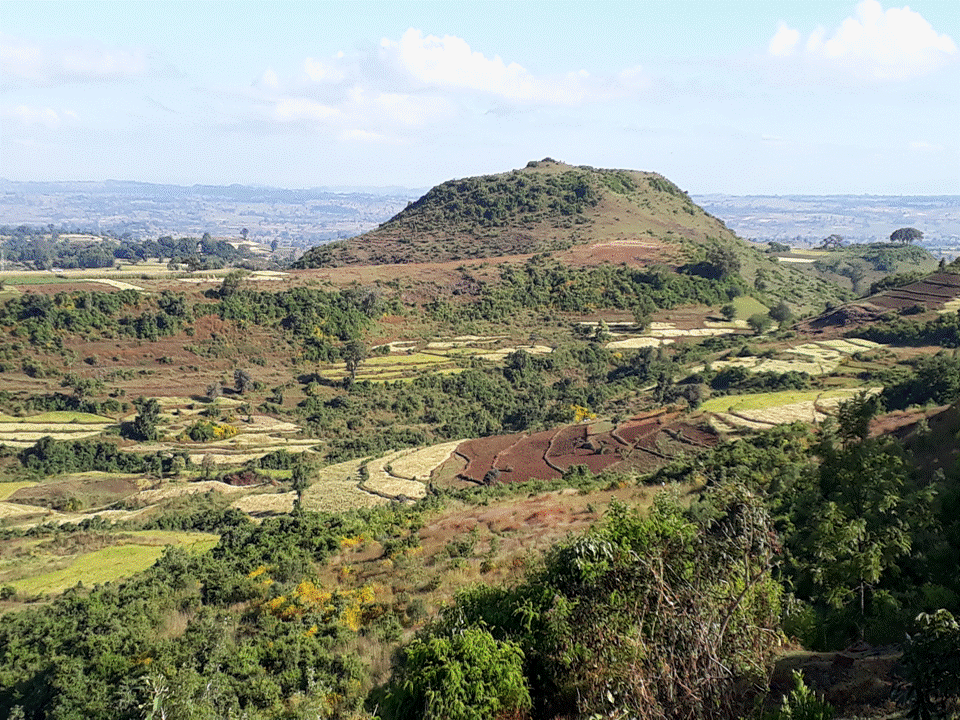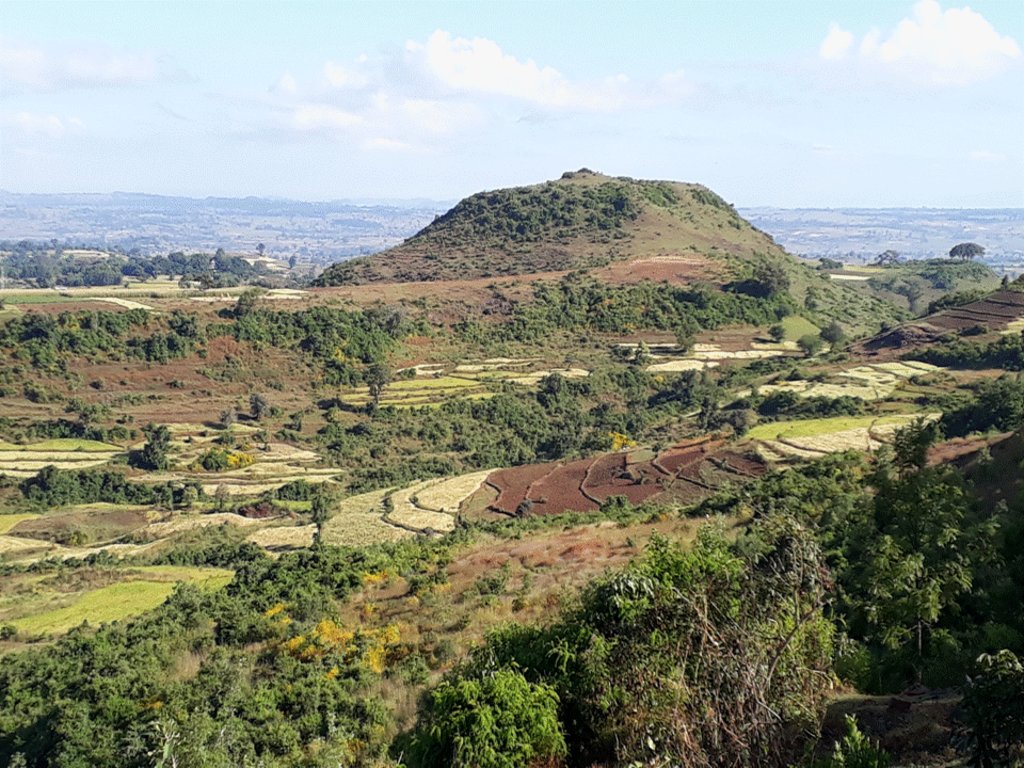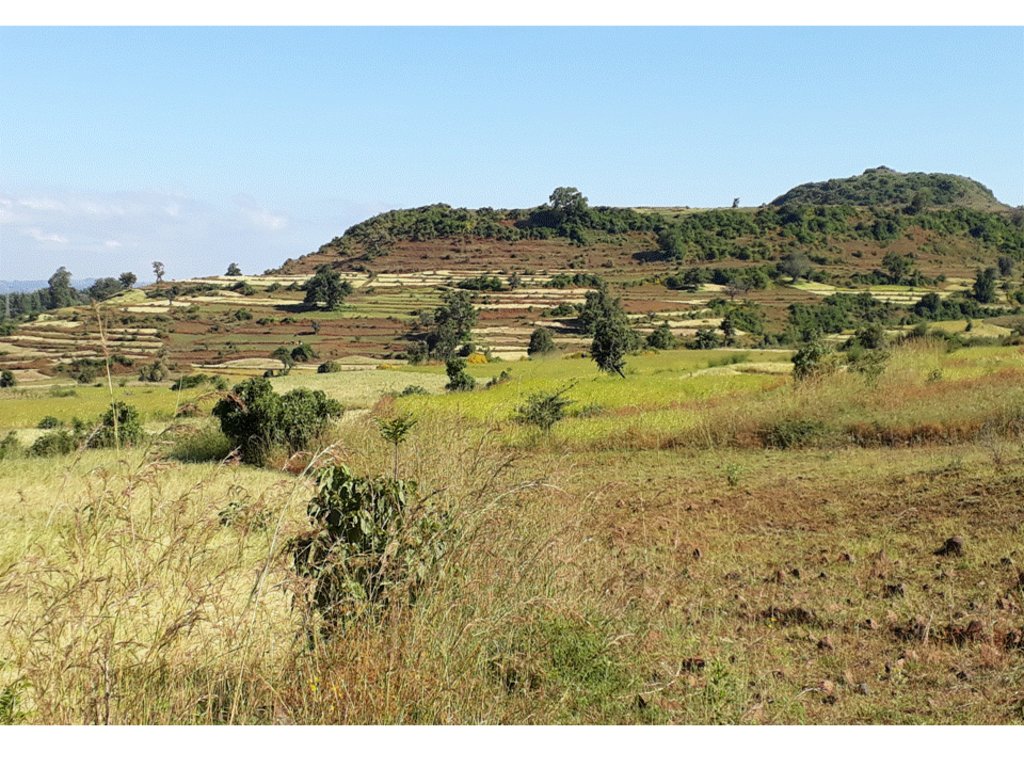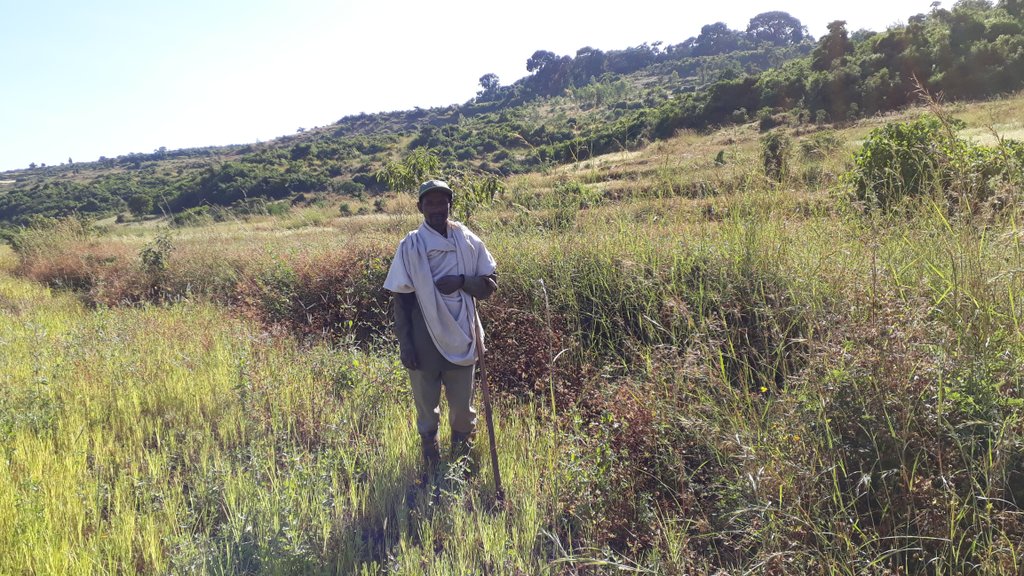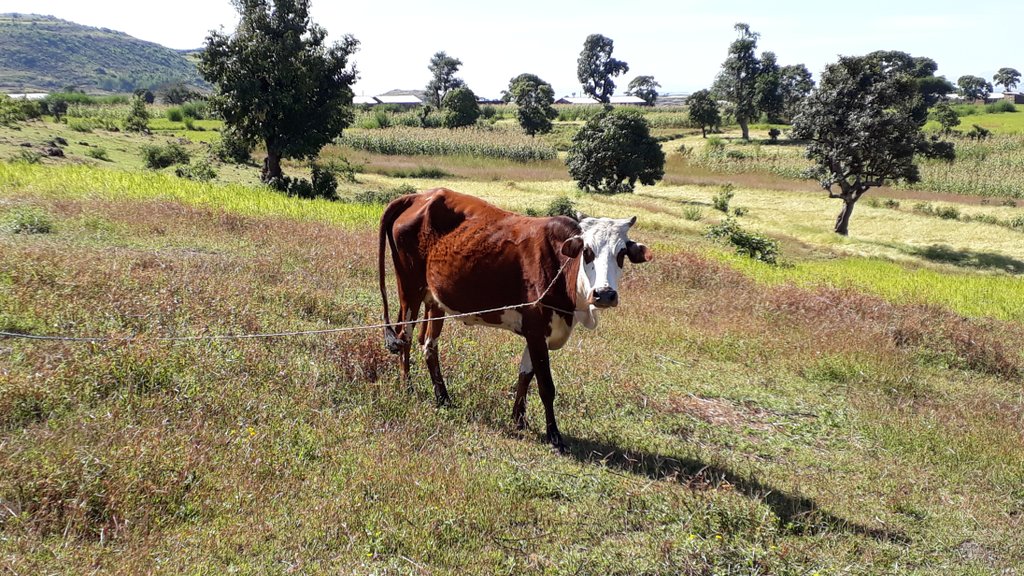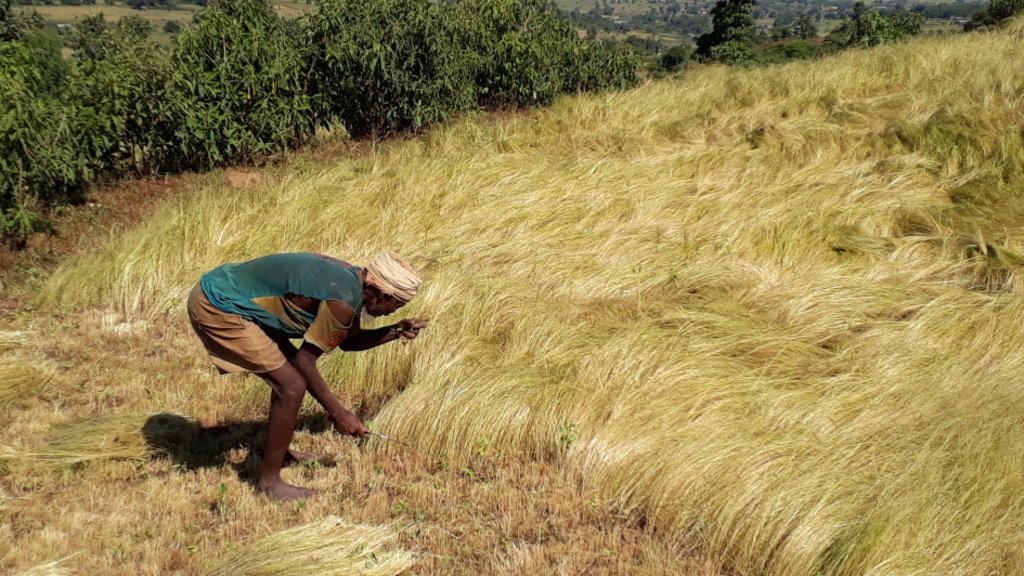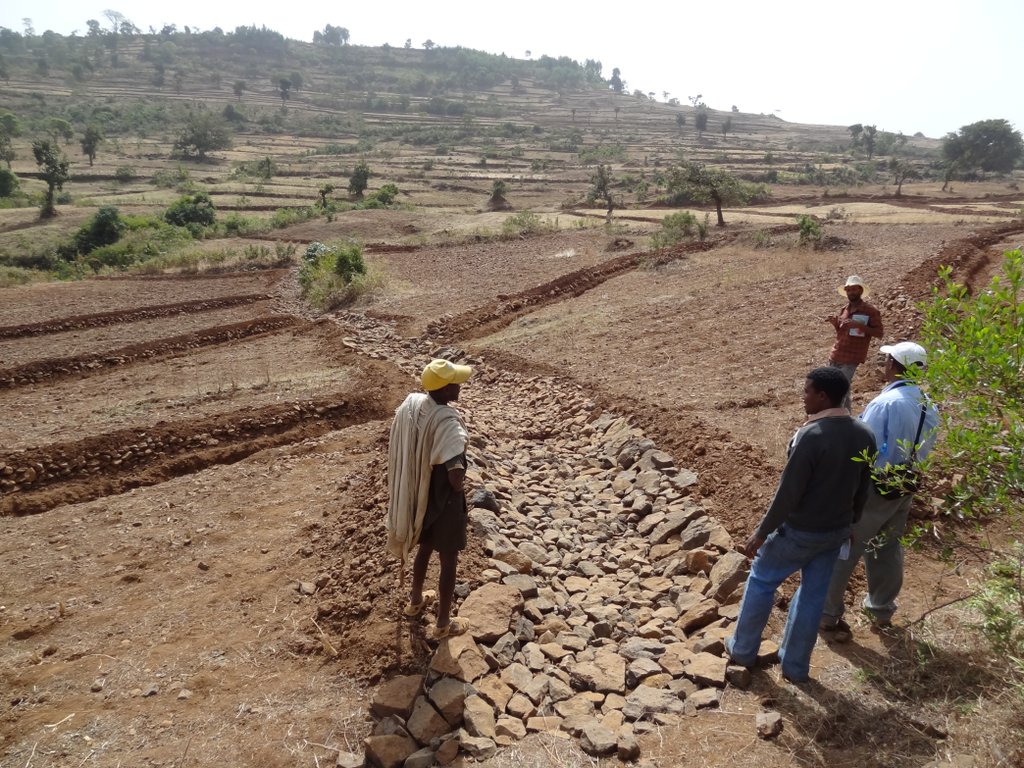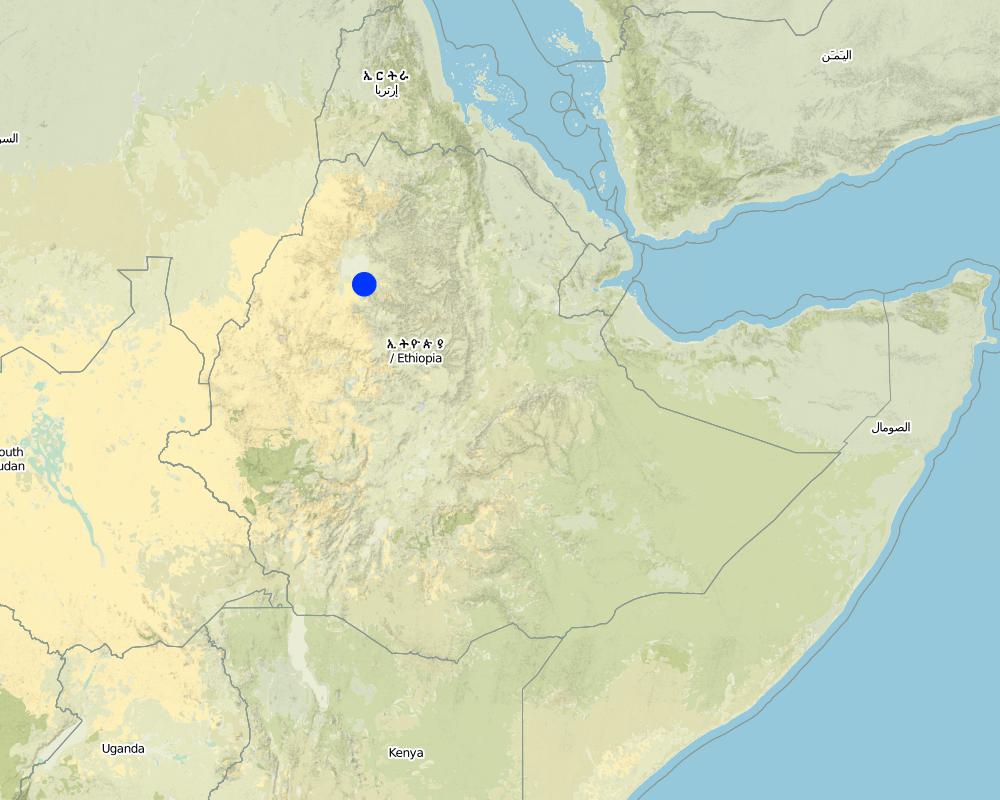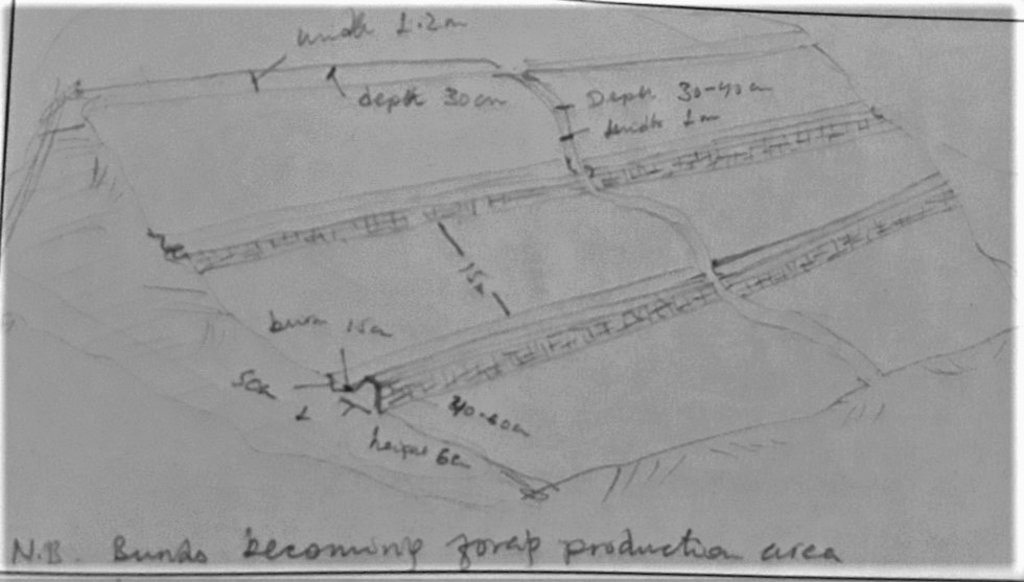Integrated Farm Land Conservation [埃塞俄比亚]
- 创建:
- 更新:
- 编制者: Yismaw Wuletaw
- 编辑者: –
- 审查者: Tatenda Lemann
የተቀናጀ የእርሻ መሬት እንክብካቤ (yetekenaje yeirsha meriet inkibikabie)
technologies_4136 - 埃塞俄比亚
查看章节
全部展开 全部收起1. 一般信息
1.2 参与该技术评估和文件编制的资源人员和机构的联系方式
关键资源人
土地使用者:
Debeb Belete
Abagerima Kebele Association
埃塞俄比亚
SLM专业人员:
有助于对技术进行记录/评估的项目名称(如相关)
Carbon Benefits Project (CBP)有助于对技术进行记录/评估的机构名称(如相关)
Bureau of Agriculture - Amhara Nation Regional State - Bahir Dar (amhboard) - 埃塞俄比亚有助于对技术进行记录/评估的机构名称(如相关)
CDE Centre for Development and Environment (CDE Centre for Development and Environment) - 瑞士有助于对技术进行记录/评估的机构名称(如相关)
Water and Land Resource Centre (WLRC) - 埃塞俄比亚1.3 关于使用通过WOCAT记录的数据的条件
编制者和关键资源人员接受有关使用通过WOCAT记录数据的条件。:
是
1.4 所述技术的可持续性声明
这里所描述的技术在土地退化方面是否存在问题,导致无法被认为是一种可持续的土地管理技术?:
否
注释:
The technology is directly related land degradation and hence it can be declared as sustainable land management technology.
2. SLM技术的说明
2.1 技术简介
技术定义:
Integrated Farm Land Conservation (IFLC) comprises of farm terrace (bund) construction, construction of drainage structures, bund stabilization and livestock exclosure,
2.2 技术的详细说明
说明:
Integrated Farm Land Conservation (IFLC) is practiced within a watershed on individual farmland. Main characteristics of the technology are conserving soil and moisture and at the same time safe disposal of excess runoff.
Farm terrace construction is actually terrace development, starting with soil or stone bunding that enables the development of a terrace, i.e. bench formation due to soil erosion, sediment deposition and tillage movement through time (5-15 years). The bunds are levelled or graded, the walls having a bottom width of 0.8 - 1.0 m, and a top width of about 0.4 m, the bund height is up to 0.6 m. Bunds are constructed parallel to the slope or slightly graded, on slopes ranging from 8 - 20 % gradients, and at a the vertical interval of 1-2 m between two bunds. The bunds are stabilized with vegetative measures like grass and legume shrubs. The drainage structures consist of the ditch along bunds, cut-off drains above cultivated land and waterways through it, the depth of a cut-off drain being 0.3 - 0.4 m and the average width 1.5 m, the depth of the waterway being 0.3 - 0.5 m, and the width of the waterway being 1.5 - 2 m. For bund and terrace protection in the initial years, livestock is excluded and farmers exercise cut and carry. Livestock exclosure encourages land users to practice crop residue management.
The purpose of the technology, in general, is to conserve soil and water, minimizing slope gradients of the farmland, improve soil moisture, reduce compaction, enhance infiltration and thus improve the recharge of groundwater. Furthermore, livestock exclosure contributes to soil fertility enhancement following crop residue management. The technology initially maintains soil fertility and through time, it has its own contribution to the betterment / increment of crop yield. Nevertheless some farmers complain about the land being occupied by the bunds, although this is later on compensated, as forage can be produced on the riser slopes of the growing terraces.
2.3 技术照片
关于照片的一般说明:
The photos were all taken during field work on 24 October 2018, while several technologies were assessed by different compilers. In the Abagerima area a full watershed was developed in 2013 by the Water and Land Resource Centre, Addis Ababa University and Centre for Development and Environment (CDE), University of Bern, funded by Swiss Development Cooperation and its Ethiopian partners.
2.5 已应用该技术的、本评估所涵盖的国家/地区/地点
国家:
埃塞俄比亚
区域/州/省:
Amhara Region, Ethiopia
有关地点的进一步说明:
Abagerima Watershed in the Highlands of Ethiopia
具体说明该技术的分布:
- 均匀地分布在一个区域
如果技术均匀分布在一个区域,则指定覆盖的区域(单位为平方千米):
3.0
如果不知道精确的区域,请注明大致覆盖的区域:
- 1-10 平方千米
技术现场是否位于永久保护区?:
否
注释:
The site is not permanently protected. The site faced some damage due on and off free grazing instead of consistently exercising cut and carry practice. In some cases deliberate damage caused by few individuals by freely grazed the site.
Map
×2.6 实施日期
注明实施年份:
2013
如果不知道确切的年份,请说明大概的日期:
- 不到10年前(最近)
2.7 技术介绍
详细说明该技术是如何引入的:
- 通过项目/外部干预
- Government led community free labor mobilization for the natural resource conservation measures
注释(项目类型等):
Government-led community free labor mobilization for the natural resource conservation measures, supported by Water and Land Resource Centre, Addis Ababa University and Centre for Development and Environment, University of Bern.
3. SLM技术的分类
3.1 该技术的主要目的
- 改良生产
- 减少、预防、恢复土地退化
- 结合其他技术保护流域/下游区域
- 适应气候变化/极端天气及其影响
- 创造有益的经济影响
3.2 应用该技术的当前土地利用类型
同一土地单元内混合使用的土地::
是
具体说明混合土地使用(作物/放牧/树木):
- 农林牧业

农田
- 一年一作
- 多年一作(非木材)
- 乔木与灌木的种植
年作 - 具体指明作物:
- 谷物类 - 玉米
- 谷类 - 小麦(冬季)
- 豆科牧草和豆类 - 其他
- teff
年作制度:
连作小麦/大麦/燕麦/旱稻
乔木和灌木种植 - 指定作物:
- 鳄梨
- 咖啡,采树荫栽培
- 芒果、山竹果、番石榴
- 木瓜
- Dodonaea angustifolia, Rhamnus Prinoides, Catha edulis
每年的生长季节数:
- 1
采用间作制度了吗?:
否
采用轮作制度了吗?:
是
如果是,请具体说明:
maize followed by pulses followed by wheat followed by teff, and rarely, fallow.

牧场
集约放牧/饲料生产:
- 收割和携带/零放牧
动物类型:
- 牛 - 奶制品
- 牛 - 非乳制品工作
- 山羊
- 骡子和驴
- 家禽
- 绵羊
- Bees
是否实行作物与牲畜的综合管理?:
是
如果是,请具体说明:
cattle is mainly used for ploughing (oxen), sheep and goats for meat.
产品和服务:
- 肉类
- 奶类
- 交通工具/役畜
品种:
牛 - 非乳制品工作
计数:
2500
品种:
山羊
计数:
830
品种:
绵羊
计数:
2000
品种:
家禽
计数:
10200
品种:
骡子和驴
计数:
1064

森林/林地
- (半天然)天然森林/林地
- 植树造林
(半天然)天然森林/林地:具体说明管理类型:
- 清除枯木/剪枝
- 非木材森林的利用
(半)天然林类型:
- 热带潮湿落叶林天然植被
植树造林:说明树种的起源和组成:
- 单一栽培的外来品种
- 混交品种
植树造林类型:
- 热带山地系统人工林
树木类型:
- 金合欢树种
- 蓝桉
- Cordia Africana, Olea african, Ficus vasta, Croton macrostachyus
以上的树木是落叶树还是常绿树?:
- 混合落叶或常绿
产品和服务:
- 木材
- 薪材
- 放牧/啃牧
注释:
Livestock population data for the whole watershed
3.3 由于技术的实施,土地使用是否发生了变化?
由于技术的实施,土地使用是否发生了变化?:
- 是(请在技术实施前填写以下有关土地利用的问题)
同一土地单元内混合使用的土地::
是
具体说明混合土地使用(作物/放牧/树木):
- 农林牧业

农田
- 一年一作
- 多年一作(非木材)
- 乔木与灌木的种植
年作 - 具体指明作物:
- 谷物类 - 玉米
- 谷类 - 小麦(冬季)
- 豆科牧草和豆类 - 其他
- teff
年作制度:
连作小麦/大麦/燕麦/旱稻
乔木和灌木种植 - 指定作物:
- 咖啡,采树荫栽培
- Dodonaea angustifolia, Rhamnus Prinoides, Catha edulis
采用间作制度了吗?:
否
采用轮作制度了吗?:
是
如果是,请具体说明:
maize followed by pulses followed by wheat followed by teff, and rarely, fallow

牧场
粗放式放牧:
- 半游牧畜牧业
- 经营牧场
动物类型:
- 牛 - 非乳制品工作
- 山羊
- 绵羊
是否实行作物与牲畜的综合管理?:
是
如果是,请具体说明:
livestock was allowed to graze all over the place before conservation, except on cultivated land during the growing season.
产品和服务:
- 肉类
- 奶类
- 交通工具/役畜

森林/林地
- (半天然)天然森林/林地
(半天然)天然森林/林地:具体说明管理类型:
- 皆伐
- 清除枯木/剪枝
(半)天然林类型:
- 热带山地系统自然植被
树木类型:
- 金合欢树种
- 蓝桉
以上的树木是落叶树还是常绿树?:
- 混合落叶或常绿
产品和服务:
- 木材
- 薪材
- 放牧/啃牧
注释:
Land use change (of Abagerima watershed over the intervention periods (2010 and 2017):
Land use change Ha.
Cultivated land to bush/ shrub land4.1
Cultivated land to degraded grass land 3.9
Cultivated land to grass land 5.8
Cultivated land to Homestead 8.0
Cultivated land to plantation 4.9
Degraded grass land to bush/ shrub land 1.2
Grass land to bush/ shrub land 3.2
Grass land to cultivated land 6.1
Grass land to degraded grass land 4.0
Grass land to riverine vegetation1.2
Source: - Achievements and Impacts of Learning Watershed Approach: Technologies, Innovations and Evidence for Scaling up WLRC Research Report 3, Addis Ababa University, 2019, Addis Ababa
3.4 供水
该技术所应用土地的供水:
- 雨养
注释:
cropping is based mainly on rain-fed, farmers utilize groundwater for perennial crop production on a small scale in their homestead development areas
3.5 该技术所属的SLM组
- 区域封闭(停止使用,支持恢复)
- 农畜综合管理
- 引水和排水
3.6 包含该技术的可持续土地管理措施

农艺措施
- A2:有机质/土壤肥力
- A5:种子管理,改良品种
- A6:残株管理
A6:对残株管理作出具体说明:
A 6.4:保留

植物措施
- V2:草和多年生草本植物

结构措施
- S1:阶地
- S2:堤、岸
- S3:分级沟渠、渠道、水道
- S4:平沟、坑

管理措施
- M1:改变土地使用类型
- M2:改变管理/强度级别
3.7 该技术强调的主要土地退化类型

土壤水蚀
- Wt:表土流失/地表侵蚀
- Wg:冲沟侵蚀/沟蚀
- Wr:河岸侵蚀
- Wo:场外劣化效应

物理性土壤退化
- Pc:压实
- Pi:覆土

生物性退化
- Bc:植被覆盖的减少
- Bh:栖息地丧失
- Bl:土壤寿命损失
- Bp:害虫/疾病增加,捕食者减少

水质恶化
- Hs:地表水良变化
- Hg:地下水/含水层水位的变化
- Hp:地表水水质下降
- Hq:地下水水质下降
3.8 防止、减少或恢复土地退化
具体数量名该技术与土地退化有关的目标:
- 防止土地退化
- 修复/恢复严重退化的土地
4. 技术规范、实施活动、投入和成本
4.1 该技术的技术图纸
技术规范(与技术图纸相关):
The height of the bund is less than 0.6 m, the width of the bund is less than 1.6 m, the average slope is 8 - 15 %, the veritcal interval between two bunds is 1- 2 m, and the average spacing between structures is about 15 m
作者:
Yismaw Wuletaw
日期:
24/10/2018
4.2 有关投入和成本计算的一般信息
具体说明成本和投入是如何计算的:
- 每个技术区域
注明尺寸和面积单位:
300 ha
具体说明成本计算所用货币:
- 美元
如相关,注明美元与当地货币的汇率(例如1美元=79.9巴西雷亚尔):1美元=:
1.0
注明雇用劳工的每日平均工资成本:
3 USD
4.3 技术建立活动
| 活动 | 时间(季度) | |
|---|---|---|
| 1. | Cutoff drain | After crop harvesting |
| 2. | Waterway | After crop harvesting |
| 3. | Stone-faced soil bund | After crop harvesting |
| 4. | Bund stabilization | At the onset of the rainy season |
4.4 技术建立所需要的费用和投入
| 对投入进行具体说明 | 单位 | 数量 | 单位成本 | 每项投入的总成本 | 土地使用者承担的成本% | |
|---|---|---|---|---|---|---|
| 劳动力 | cutoff-off drain | Person day | 2600.0 | 3.0 | 7800.0 | 1.0 |
| 劳动力 | Waterway | Person day | 3500.0 | 3.0 | 10500.0 | 1.0 |
| 劳动力 | Stone-faced soil bund | Person day | 14100.0 | 3.0 | 42300.0 | 1.0 |
| 劳动力 | Bund stabilization | Person day | 1500.0 | 3.0 | 4500.0 | 1.0 |
| 其它 | Hand tools (shovel, pick-ax) | No | 1080.0 | 2.89 | 3121.2 | 0.0 |
| 其它 | Water level | No | 24.0 | 2.17 | 52.08 | 0.0 |
| 技术建立所需总成本 | 68273.28 | |||||
| 技术建立总成本,美元 | 68273.28 | |||||
如果土地使用者负担的费用少于100%,请注明由谁负担其余费用:
Government-led community free labor mobilization for the natural resource conservation measures, supported by Water and Land Resource Centre, Addis Ababa University and Centre for Development and Environment, University of Bern.
注释:
The community contributed free labor contribution. The government and Water and Land Resource Center provided technical(capacity building and monitoring) and input support.
According to the 2019 Project unpublished report, the total person days (pds) for Abagerima Community Watershed is 181,920 and for Integrated Farm land Conservation approximately 43,400 person days (Source: Gombat and Laguna Kebele level Office of Agriculture). By virtue, the community contributed their labour almost for half working day (four hours) the total person days have been divided by 2 and multiplied by 3 USD (which is the approximate daily rate).
Regarding the tool cost, the cost was covered by the government and the project (WLRC).
4.5 维护/经常性活动
| 活动 | 时间/频率 | |
|---|---|---|
| 1. | Cutoff drain | After crop harvesting |
| 2. | Waterway | After crop harvesting |
| 3. | Stone-faced soil bund | After crop harvesting |
| 4. | Bund stabilization | At the onset of the rain |
4.6 维护/经常性活动所需要的费用和投入(每年)
| 对投入进行具体说明 | 单位 | 数量 | 单位成本 | 每项投入的总成本 | 土地使用者承担的成本% | |
|---|---|---|---|---|---|---|
| 劳动力 | Stone faced soil bund | person day | 10000.0 | 3.0 | 30000.0 | 1.0 |
| 劳动力 | Bund stabilization | person day | 200.0 | 3.0 | 600.0 | 10.0 |
| 技术维护所需总成本 | 30600.0 | |||||
| 技术维护总成本,美元 | 30600.0 | |||||
如果土地使用者负担的费用少于100%,请注明由谁负担其余费用:
The community contributed free labor contribution. The WLRC provided capacity development and input support.
4.7 影响成本的最重要因素
描述影响成本的最决定性因素:
The season, as especially during sowing, weeding and harvesting times the labour costs are scarce and hence, high.
5. 自然和人文环境
5.1 气候
年降雨量
- < 250毫米
- 251-500毫米
- 501-750毫米
- 751-1,000毫米
- 1,001-1,500毫米
- 1,501-2,000毫米
- 2,001-3,000毫米
- 3,001-4,000毫米
- > 4,000毫米
农业气候带
- 半湿润
5.2 地形
平均坡度:
- 水平(0-2%)
- 缓降(3-5%)
- 平缓(6-10%)
- 滚坡(11-15%)
- 崎岖(16-30%)
- 陡峭(31-60%)
- 非常陡峭(>60%)
地形:
- 高原/平原
- 山脊
- 山坡
- 山地斜坡
- 麓坡
- 谷底
垂直分布带:
- 0-100 m a.s.l.
- 101-500 m a.s.l.
- 501-1,000 m a.s.l.
- 1,001-1,500 m a.s.l.
- 1,501-2,000 m a.s.l.
- 2,001-2,500 m a.s.l.
- 2,501-3,000 m a.s.l.
- 3,001-4,000 m a.s.l.
- > 4,000 m a.s.l.
说明该技术是否专门应用于:
- 不相关
5.3 土壤
平均土层深度:
- 非常浅(0-20厘米)
- 浅(21-50厘米)
- 中等深度(51-80厘米)
- 深(81-120厘米)
- 非常深(> 120厘米)
土壤质地(表土):
- 中粒(壤土、粉土)
土壤质地(地表以下> 20厘米):
- 中粒(壤土、粉土)
- 细粒/重质(粘土)
表土有机质:
- 中(1-3%)
- 低(<1%)
5.4 水资源可用性和质量
地下水位表:
< 5米
地表水的可用性:
中等
水质(未处理):
不良饮用水(需要处理)
水质请参考::
地表水
水的盐度有问题吗?:
否
该区域正在发生洪水吗?:
否
5.5 生物多样性
物种多样性:
- 低
栖息地多样性:
- 低
5.6 应用该技术的土地使用者的特征
定栖或游牧:
- 定栖的
生产系统的市场定位:
- 混合(生计/商业)
非农收入:
- 低于全部收入的10%
相对财富水平:
- 贫瘠
- 平均水平
个人或集体:
- 个人/家庭
机械化水平:
- 手工作业
- 畜力牵引
性别:
- 女人
- 男人
土地使用者的年龄:
- 青年人
- 中年人
5.7 应用该技术的土地使用者使用的平均土地面积
- < 0.5 公顷
- 0.5-1 公顷
- 1-2 公顷
- 2-5公顷
- 5-15公顷
- 15-50公顷
- 50-100公顷
- 100-500公顷
- 500-1,000公顷
- 1,000-10,000公顷
- > 10,000公顷
这被认为是小规模、中规模还是大规模的(参照当地实际情况)?:
- 小规模的
5.8 土地所有权、土地使用权和水使用权
土地所有权:
- 州
- 个人,有命名
土地使用权:
- 社区(有组织)
- 个人
用水权:
- 自由进入(无组织)
- 个人
土地使用权是否基于传统的法律制度?:
否
注释:
In case of drinking water, there is some organization to manage the resource
5.9 进入服务和基础设施的通道
健康:
- 贫瘠
- 适度的
- 好
教育:
- 贫瘠
- 适度的
- 好
技术援助:
- 贫瘠
- 适度的
- 好
就业(例如非农):
- 贫瘠
- 适度的
- 好
市场:
- 贫瘠
- 适度的
- 好
能源:
- 贫瘠
- 适度的
- 好
道路和交通:
- 贫瘠
- 适度的
- 好
饮用水和卫生设施:
- 贫瘠
- 适度的
- 好
金融服务:
- 贫瘠
- 适度的
- 好
6. 影响和结论性说明
6.1 该技术的现场影响
社会经济效应
生产
作物生产
注释/具体说明:
It is because of integrated farmland conservation measures and improved use of agricultural input
作物质量
饲料生产
饲料质量
注释/具体说明:
Weed also grows together with forage grass and reduces the quality of grass.
畜牧生产
木材生产
森林/林地质量
非木材林业生产
生产故障风险
产品多样性
生产区域
土地管理
水资源可用性和质量
饮用水的可用性
饮用水的质量
家畜用水的可用性
家畜用水的质量
灌溉用水的可用性
灌溉用水的质量
灌溉用水需求
收入和成本
农业投入费用
农业收入
收入来源的多样性
经济差异
工作量
社会文化影响
食品安全/自给自足
健康状况
土地使用权/用水权
社区机构
SLM/土地退化知识
冲突缓解
社会经济弱势群体的情况
生态影响
水循环/径流
水量
水质
水的回收/收集
地表径流
多余水的排放
地下水位/含水层
蒸发
注释/具体说明:
This includes evapotranspiration
土壤
土壤水分
土壤覆盖层
土壤流失
土壤堆积
土壤结壳/密封
土壤压实
养分循环/补给
注释/具体说明:
Crop residue management following livestock exclosure from the farmland.
盐度
土壤有机物/地下C
酸度
生物多样性:植被、动物
植被覆盖
生物量/地上C
植物多样性
外来入侵物种
注释/具体说明:
Not alien species, but the common weed species getting spread.
动物多样性
有益物种
注释/具体说明:
But the bee colony is getting decreased due to the use of pesticide and insecticide.
栖息地多样性
害虫/疾病控制
减少气候和灾害风险
洪水影响
滑坡/泥石流
干旱影响
飓风、暴雨的影响
碳和温室气体的排放
注释/具体说明:
Due to minimizing the number of livestock from time to time. It is due to the fact that farmers are unable to manage under better/ intensive management following controlled grazing.
火灾风险
风速
微气候
6.2 该技术的场外影响已经显现
水资源可用性
旱季稳定可靠的水流
注释/具体说明:
Seasonal streams apparently have runoff longer into the dry season than before soil and water conservation, according to land users' observations.
下游洪水
下游淤积
地下水/河流污染
缓冲/过滤能力
风力搬运沉积物
对邻近农田的破坏
6.3 技术对渐变气候以及与气候相关的极端情况/灾害的暴露和敏感性(土地使用者认为的极端情况/灾害)
渐变气候
渐变气候
| 季节 | 增加或减少 | 该技术是如何应对的? | |
|---|---|---|---|
| 年温度 | 增加 | 好 | |
| 季节性温度 | 旱季 | 增加 | 好 |
| 年降雨量 | 好 |
气候有关的极端情况(灾害)
气象灾害
| 该技术是如何应对的? | |
|---|---|
| 热带风暴 | 好 |
| 局地暴雨 | 好 |
| 局地雷暴 | 适度 |
| 局地雹灾 | 适度 |
6.4 成本效益分析
技术收益与技术建立成本相比如何(从土地使用者的角度看)?
短期回报:
消极
长期回报:
积极
技术收益与技术维护成本/经常性成本相比如何(从土地使用者的角度看)?
短期回报:
稍微积极
长期回报:
积极
注释:
The farmland owner considers "with" and "without" scenario and the comparative labour cost.
6.5 技术采用
- > 50%
在所有采用这项技术的人当中,有多少人是自发的,即未获得任何物质奖励/付款?:
- 91-100%
6.6 适应
最近是否对该技术进行了修改以适应不断变化的条件?:
否
6.7 该技术的优点/长处/机会
| 土地使用者眼中的长处/优势/机会 |
|---|
| 1. Conserving the soil and water and hence reduce flood hazard, 2. Avoiding traditional ditches and minimizing conflict due flood, 3. Minimizing/ lowering the slope of the farmland, 4. Improving the surface and groundwater potential, 5. Contributing to the betterment of yield, |
| 编制者或其他关键资源人员认为的长处/优势/机会 |
|---|
| 1. Conserving the soil and water and hence reduce flood hazard, 2. Avoiding traditional ditches and minimizing conflict due flood, 3. Minimizing/ lowering the slope of the farmland, 4. Improving the surface and groundwater potential, 5. Maintain soil fertility and through time improves the fertility status, 6. Contributing to the betterment of yield. |
6.8 技术的弱点/缺点/风险及其克服方法
| 土地使用者认为的弱点/缺点/风险 | 如何克服它们? |
|---|---|
| Expansion of rodents, | Construction of ditches to protect rodents around the farm. |
| Land occupied by the structures. | Producing forage on the structures including bunds and drainage structures. |
| 编制者或其他关键资源人员认为的弱点/缺点/风险 | 如何克服它们? |
|---|---|
| Unable to utilize more the area occupied by the structure. | Considering agroclimatic situation of the area, there is an opportunity to produce high-value crops. So, better to consider forage, selected fruit or other trees that will produce short, medium and long-term benefits. |
| Limitation on integration of biological measures (agronomic measures), like green manuring, inter-cropping to improve soil fertility and hence minimize flood/erosion, and to improve productivity, | Providing inputs aiming at demonstrating how to practice green manuring (like Lupine, Sesbania sesban) and inter-cropping (like pigeon pea, which offers additional production besides to soil fertility). |
| Limitation, partially, on maintaining the interval between two successive bunds. | Establishing grass, bushes, fruit hedgerows in between two successive bunds. |
| Limitation on the number of tillage operations. | Minimizing the number of tillage for annual crop production not to further disturb soil aggregates and enhance sealing and run off. Better to consider conservation agriculture (CA) if capacity building and input provision is put in place for demonstration and dissemination. |
| Limitation on institutional capacity building (from the community watershed committee up to the regional and federal levels) regarding the concept of Integrated farm land conservation (the view is focused more on physical structures and to some extent on bund stabilization). | Building the capacity of the respective heads/ leaders/ community representatives on the role of integrating bio-physical and soil fertility enhancement measures so as to maximize the benefits of soil and moisture conservation, improve infiltration/ recharging, minimize soil erosion, enhance soil fertility and hence crop productivity in a sustained manner. Thus the contribution for carbon sequestration is also enhanced. |
| The declining trend in traditional crop rotation leads to soil fertility depletion and aggravates crop pests. | Improving soil fertility, use of input (selective crop varieties and organic and inorganic fertilizers), and improving the traditional crop rotation so as to minimize soil fertility depletion. |
7. 参考和链接
7.1 信息的方法/来源
- 实地考察、实地调查
Two
- 与土地使用者的访谈
Mr. Belete Debeb
- 与SLM专业人员/专家的访谈
Mr. Melese Bililgin
(现场)数据是什么时候汇编的?:
24/10/2018
注释:
Transect walk was undertaken through the watershed. An interview was done with the land user.
7.2 参考可用出版物
标题、作者、年份、ISBN:
Integrated Farm Land, Conservation, Yismaw Wuletaw, 2018
可以从哪里获得?成本如何?
Can be obtained from author
7.3 链接到网络上的相关信息
标题/说明:
none
URL:
-
7.4 一般注释
The questionnaire is easily understood and can be filled provided that the information can be collected in the field or with informants.
General remark: The comments are forwarded, as observed at field, because when we talk about Integrated Farm Land Conservation (IFLC), it should be integrated as much as possible/ inclusive for better results, as the ultimate goals of IFLC are:
oEnvironmental benefits - Conserving soil and moisture, carbon sequestration, improving the local climate;
oEconomic benefits - improving crop productivity, generating forage as a result of structural stabilization, and if it is implemented in an organized manner, it can also generate further economic benefits from gesho, fruit and selected trees like Grevillea robusta and Acacia dicurrens planted on structures;
oSocial benefits – contributing to social prestige as a result of producing reasonable production (if the concept of “optimizing the productivity per unit area, water and time” is respected, the livelihood of the rural community is also improved simply due to maintaining healthy soil and use of input for structural stabilization – i.e making the structures productive. In advanced terms, if IFLC is implemented in a well organized manner, the production through protection concept will be maintained. Thus, IFLC will contribute to the stability of the community within their surroundings/ watersheds and enable the transferring healthy soil/ land for the next generation.
链接和模块
全部展开 全部收起链接
无链接
模块
无模块


